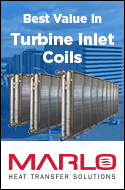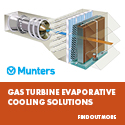FAQS
Fogging Direct Evaporative Cooling
Q1: What type of water is used? Q1: What type of water is used?
A1: Demineralized water is preferred to prevent suspended solids from plating out in the compressor and causing loss of efficiency or air cooling achieved.
Q2: Can I control how much cooling I get?
A2: Depends on the ambient humidity and dry-bulb temperature. When the humidity is 45% RH and the dry-bulb temperature is 96°F fogging can achieve up to about 21°F of cooling. If less cooling is needed/desired, change the approach to the saturation of the air by controlling the amount water injected.
Q3: How long must my gas turbine be down to install fogging?
A3: The common plant outage time of 3 to 5 days is adequate for installing a fogging system.
Q4: What pressure does a fogging system operate at?
A4: Optimal designed systems use a variable frequency drive to vary the pressure to pinless nozzles. The nozzles used have great spray quality at pressures of 400 to 3000 psig. Higher pressure systems require fewer nozzles.
Q5: How much power is used for fogging?
A5: The newest technology systems use waffle plate multiple piston pumps that require between 1.4 and 1.9 horsepower per gallon per minute of water at a pressure of 2300 PSIG.
Q6: What kind of coating system is used to protect fogging system from corrosion?
A6: An epoxy coating system that is suitable for a water-submerged service.
Q7: Can I use fogging with my Chiller?
A7: Yes, depending on the location. in arid areas a fogger system can be used downstream of a with the a chiller system.
Q8: How often do I have to change fogging nozzles?
A8: With good filters, correct demineralized water, and proper filter changes, nozzles will last upwards of 40,000 hours of operating.
Q9: How much maintenance is required for a fogging system?
A9: Inlet filters and discharge filters should be changed at a minimum of two times per operating season. Pumps should be inspected once per operating season.
Q10: How close to 100% RH can I get with a fogging system?
A10: With a feedback system, It is possible to get to 99% RH at the bell mouth, provided there are no places in the pathway for the water to agglomerate on and cause larger droplets to become entrained in the air and cause damage to the compressor.
Q11: What is the percentage increase in output I can see from installing a fogger?
A11: Depends on the ambient humidity and the dry-bulb temperature. In most areas you will see 5-7% increase in output. In arid areas you can see up to 15% increase in output.




